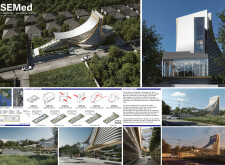5 key facts about this project
### Project Overview
The SEMed Clubhouse and Wellness Centre, situated in the Rangit district of Bangkok, Thailand, addresses specific local environmental challenges, particularly flooding. Designed as a multi-functional facility, it integrates a modern architectural aesthetic with practical responses to its geographical context, prioritizing both functionality and visual engagement within the community.
### Design Principles and Strategies
The design is rooted in sustainability and resilience, responding to local climatic conditions to mitigate flooding risks through strategic architectural solutions. The development process is organized into six phases: compliance with local regulations, capacity assessment for community activities, establishment of buffer zones to enhance interaction with the environment, creation of inclusive community areas, design for natural ventilation and airflow management, and incorporation of flood mitigation features. Each phase exemplifies a dedication to environmental stewardship and user safety.
### Architectural Features and User Spaces
The architectural expression is characterized by a curvilinear form that reflects water dynamics, enhancing both natural ventilation and visual appeal.
- **Material Selection**: The project utilizes a variety of materials, including glass for transparency, steel for structural resilience, concrete for foundation stability, and wood for warmth and human-centric design.
- **Functional Layout**: The building's multi-level layout accommodates diverse wellness and community activities. The first and second floors are dedicated to accessible community spaces, while the upper levels provide areas for administrative functions and quieter wellness activities, optimizing both views and privacy. Sustainable design features include effective drainage systems and green roofs that promote biodiversity and stormwater management.
The SEMed Clubhouse exemplifies a thoughtful approach to architectural design, responding to environmental challenges while fostering community interaction and well-being.


















































